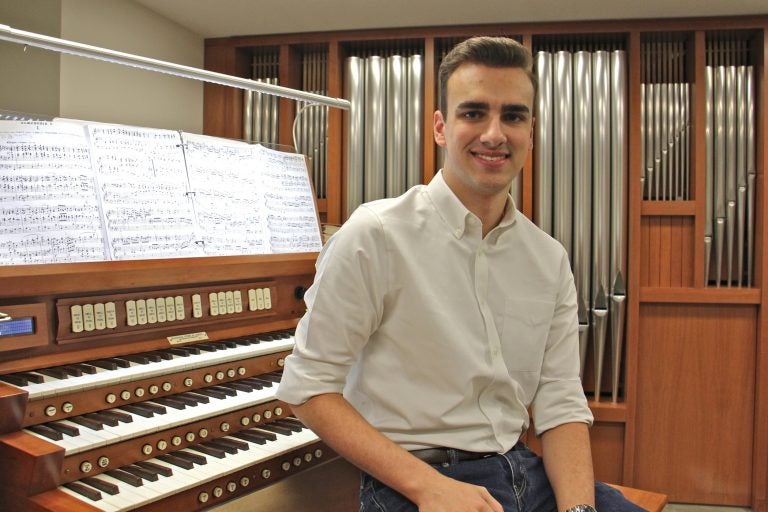Hunting Philly neighborhoods for forgotten church pipe organs
The Philadelphia-based nonprofit Partners for Sacred Spaces is visiting churches in the city’s outlying neighborhoods to document forgotten pipe organs.
Listen 3:29
Adrian Binkley, an student at the Curtis Institute of Music in Philadelphia, has been surveying church pipe organs in churches outside Center City. (Emma Lee/WHYY)
For a year now, Adrian Binkley has gone into more than 30 churches around Philadelphia, hunting for sound.
Binkley, a student of the organ at the Curtis Institute of Music, was tapped to be part of the Partners for Sacred Places survey of the city’s stock of pipe organs.
“Some are used weekly and are in tune and maintained,” he said. “Others haven’t been touched in 10, 20, sometimes 25 years.”
Binkley recently visited the St. James United Methodist Church in Olney, a 19th-century church that has had its ups and downs. The organ there is not played very often; the congregation prefers to use guitar and a drum kit during worship services.
The Partners for Sacred Places, a Philadelphia-based nonprofit, is determined to identify 50 church pipe organs outside Center City. Project director Joshua Castaño says downtown churches are pretty well-documented already.
“Those sacred places, they tend to have more capacity and resources and people tend to know more about those instruments,” said Castaño. “We wanted to go outside Center City where there are not as many sets of eyes or as much knowledge about the condition of the pipe organs there.”

Pipe organs are literally built into the architecture of a building. They are complex instruments that involve thousands of parts, many of them hand-made. They can easily fall into disrepair, subsequently becoming ignored by their congregations because they are too expensive to fix.
Just getting access to the organ has proven to be a challenge for the surveyors. Many congregations have been shrinking for years and don’t have staff (neither paid nor volunteer) to keep an office during business hours. Just getting someone to pick up the phone or return an email can be difficult.
On top of that, churches with financial and structural problems may not want strangers poking around.
“Some congregations feel very vulnerable,” said Castaño. “That’s why they are less apt to respond to a cold-call from someone they don’t know, or from an organization that wants to dig into their situation.”
Once inside, surveyors like Binkley carry an iPad loaded with a checklist. He is not making a full assessment of each instrument, but rather a perfunctory once-over of its general condition: Is it accessible? Is it playable? Are all the keys there? How many pipe racks does it have? Who manufactured it, and when?
Sometimes they find surprises.
“A little Episcopal church in Kensington, the Free Church of St. John, has a little organ by a cool, American 19th-century-maker,” said Castaño. “It’s a Jardine. I think it’s one of the only Jardines in the city. It’s all there and it works. Sometimes there are these little jewels out there that are super cool.”
Castaño has a goal of surveying 50 church pipe organs. So far the project, called Playing and Preserving, has visited 38 of them. He knows there are more out there.
Once the survey is done, Partners for Sacred Places will identify 10 congregations for a full, professional assessment of their instrument, and then work with them to attract resources and training to maintain and leverage it as a public asset.
The third part of the project is programming concerts. Classical musicians with Astral Artists, an artist supported organization, are working with the youth education program Play On Philly to stage concerts with the pipe organ at St. Mary’s Hamilton Village, the historic church in the middle of the University of Pennsylvania campus.
The first concert was last week. Two more are scheduled for the weekend before Thanksgiving and the weekend before Christmas.
“Music is an amazing human cultural element. Seriously, it’s universal, right?” said Castaño. “The organ is a way to get people who are around a sacred place interested in that place. It’s a way to actually hear a building.”
WHYY is your source for fact-based, in-depth journalism and information. As a nonprofit organization, we rely on financial support from readers like you. Please give today.





